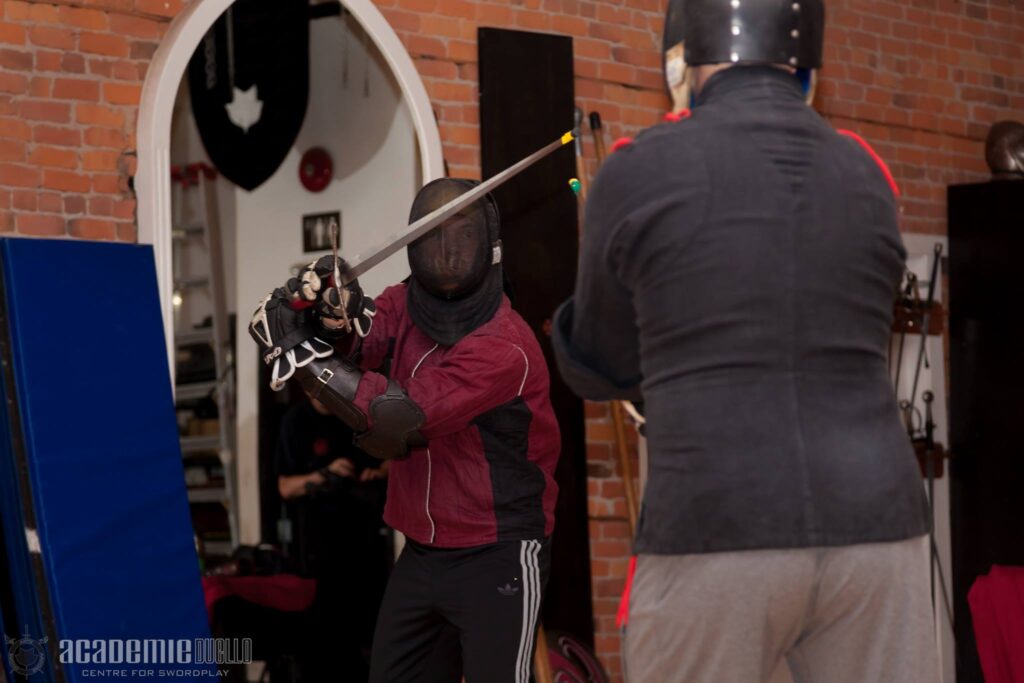From Longsword Apprentice to Free Scholar

It’s an exciting week for Academie Duello and Duello Armizare. We’re running our first Free Scholar exam specifically for Longsword on Friday, September 30, 2022. Armizare Scholar Ben Davis will be participating in a three-hour examination that includes skill demonstrations for Abrazare (wrestling), Sidesword & Buckler, and Longsword, as well as a combative examination where he will face all comers in 40 minutes of full-speed sparring.
Where We Began
Eighteen years ago when Academie Duello first started as a professional school, Duello Armizare was delivered as a multi-disciplinary program that began with the rapier and wrestling and then gradually progressed through additional disciplines such as sidesword, longsword, and polearms over the course of five successive ranks.
Duello Armizare is a unified art where each discipline is used to teach and deepen universal principles applied across diverse weapons. So regardless of which weapon you start with, every piece is a part of the entire martial mosaic that gradually takes shape throughout your time at the school. Though some people were interested in the longsword at the start of their studies, they were happy to work through our foundational levels before picking up the two-handed weapon at a later stage.
Over the years this process was tremendously successful. By the time that a student got to Free Scholar and started to work with the longsword, they already had the foundational principles to be successful with it: those of blade control, sensitivity in the bind, control of tempo, and management of the tactical space. They then only needed to explore and expand into the areas that the longsword represents best: multi-directional combat, power generation and flow, the interface between swordplay and grappling, among others.
Yet as the winds of popular culture changed, so did the interests of people coming into the school. More and more people coming in the door wanted to start from the medieval side and didn’t want to wait. There is also an historical precedent for Italian ranked schools to allow for various starting disciplines and not just one. So seven years ago we decided to adopt the change and created a longsword branch for entry into our art. Though a student is still required to gain proficiency in all disciplines to achieve their Provost (level 4) and Master (level 5) ranks, they could now start with either the rapier or longsword as their first primary discipline.
You can read more about the Duello Armizare art and levels here.
The Longsword Path: Apprentice (Level 1)
The Apprentice level for the longsword focuses on developing foundational skills with the sword within six themes:
Gioco Largo – Employing and countering situations where the opponent’s weapon is withdrawn or moving away from threat, the centre is open(ing), and the blades are far from one another. Core skill areas include cutting attacks, parries, clearing, recovery, and working with force and inertia.
Gioco Stretto – Working from positions where the opponent’s point is threatening, and where yours and your opponent’s swords are in contact or close to one another. Core skill areas include blade control, point work, closing lines, delivering controlling thrusts/cuts, and working from and against point-online guards.
Approaching – Collapsing the distance between you and the opponent. Seeking to capture control, and force the opponent into obedience (defensive responses). Core skill areas include tactical constraint, reading the opponent, delivering first-intention attacks.
Receiving – Inviting the opponent to come to you. Seeking to capture control and allow the opponent to run onto your weapon as well as the skills required to recover control and act positively from defensive positions. Core skill areas include defending, recovering control, counter-attacking, inviting, striking in contratempo (counter-time), and due tempi (two tempos).
Grappling – Unarmed grappling skills from both clinching and open positions as well as grappling at the sword. Core skill areas include posture and structure, movement skills, feeling and responsiveness, disarms, arm locks and binds, takedowns and throws.
Forms & Guards – A dive into martial sequences from historical traditions. This is an opportunity to connect with old masters while learning about continuity, flow, and precision. Also an opportunity to explore individual guard positions to assess their offensive and defensive purposes.
Achievement of competency at this level awards the Scholar rank.
The Longsword Path: Scholar (Level 2)
Once someone achieves their Scholar rank the curriculum expands:
Strategy and Tactical Control – Learning how to assess opponents and apply the True Fight against opponents based on a set of core combative attitudes.
The Deceptive Fight – The use of false attacks and openings to lure the opponent into predictable and exploitable actions.
Expanded Gioco Largo and Stretto – Next level concepts and skills of largo and stretto and exploration of the use of largo and stretto as strategies beyond simply being circumstances you find yourself in.
Unarmed Combat – Clinch wrestling holds to all parts of the body, striking and striking defense, entries, control, constraint, takedown and submission.
Grappling at the Sword – Grappling vocabulary at the five distances (blade, hand, elbow, shoulder, back), tactical control and practical application, counter-grappling, as well as fundamentals of armoured half-swording.
Sidesword & Buckler – Foundational postures, attacks, defenses, grappling, use of the buckler, countering the buckler, and three traditional martial form sequences.
Before testing for Free Scholar the student is expected to build foundational competency within the new themes while also developing a level of applied proficiency in the skills they first learned at Apprentice. Achievement of proficiency at this level awards the Free Scholar rank.
Assessment and Examination
Rank progression is about accelerated learning, not gatekeeping. In Duello Armizare we do not hide any of the techniques of a given level—I’m happy to share any of the techniques of our system with anyone. Rank progression simply provides a path of focus that helps students toward proficiency and mastery in the most efficient way possible. Levels also help focus training and create the necessary pressure to test whether skills truly live “in the body”, or just in the mind.
Each level is completed through a final examination, but on the way students gradually assess, refine, and sign-off on skills individually through a detailed series of mini-assessments.
All of the skills of a particular level are broken into assessment modules. Each module is a group of similar skills that can be individually assessed or assessed as a group. Students can then work their way through the curriculum by practicing skills and then submitting them for assessment in person or online. Assessing instructors give individual feedback and homework to help students develop their skills and provide sign-off when a skill has met the requirements of the level. A student’s attention can then be focused on other modules.
Once all of the modules for a level have been signed off then the student is ready to begin prepping for their final public examination.
What’s in an Exam
In the absence of true trial by earnest combat, exams provide a training destination and testing ground for skills under pressure. We take our exams seriously and not all students pass them on first attempt. The goal is to put skills under duress, find out which skills have truly been integrated, and determine if the candidate will progress best on their journey by graduating to the next level or continuing at their current one until the next examination opportunity.
The demonstration section of the exam requires candidates to show skills from the various themes of that level in controlled and challenging settings. These include drills, combative exercises, and directed sparring.
The combat section (20 minutes for the Scholar exam, 40 minutes for the Free Scholar exam) has candidates demonstrate the foundational skills for that level under combative duress. They fight at full speed against all comers with a focus on demonstrating their technical and strategic capabilities. For the Scholar-to-Free Scholar exam they are also required to maintain at least a 50% win percentage—at this level outcomes matter.
Feedback and Follow-up
Getting to an exam is a process worthy of celebration whether a student passes or fails. (Free Scholar candidates undergo years of evaluation, and dozens and dozens of highly stringent skill assessments.) Every exam provides an opportunity for focus in one’s training and is a source of useful feedback. We give detailed report cards to our candidates regardless of result. We also use the opportunity to reflect as instructors and determine if there are ways we can improve, refine, or change our curriculum based on what we have seen from the candidates.
I am proud of Ben, our school, and our instructor team for being able to have this examination and provide this new path to the Free Scholar rank. It’s exciting that those inspired by the medieval longsword can now walk in off the street and find themselves on the fruitful and engrossing journey of mastery.



